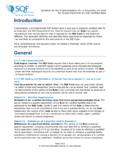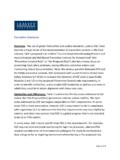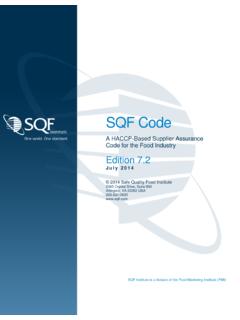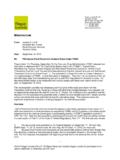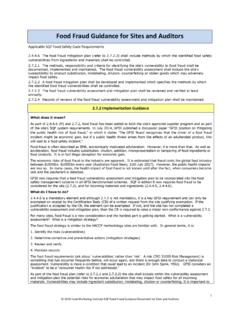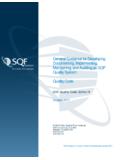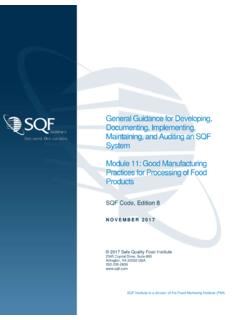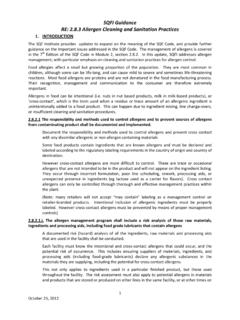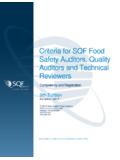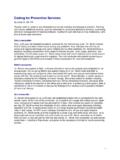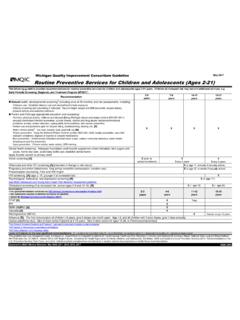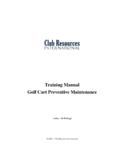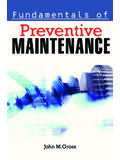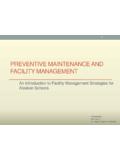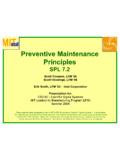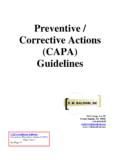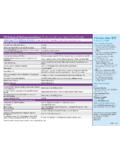Transcription of SQF Level 2 – Proposed Preventive Controls Comparison
1 Page 1 of 84 htt p:// leav it tpart ners. com / global-f ood-s olut ions Cont act : dav id. ac hes on@leav itt part om Introduction SQF Level 2, which focuses on food safety, is a Global Food Safety Initiative (GFSI) benchmarked scheme that is increasingly recognized within the food industry. As global food regulations evolve, SQF recognizes the need to keep pace with the changing regulatory requirements of the various countries in which certification is used. The signing of the US FDA Food Safety Modernization Act (FSMA) by the President in January 2011 is the most sweeping overhaul of the food-safety system in the United States since the Food, Drug, and Cosmetic Act of 1938. As of January 2013, one of several FSMA Proposed rules entitled Current Good Manufacturing Practice and Hazard Analysis and Risk-Based Preventive Controls for Human Food (the Preventive Controls Rule or the Proposed Rule ) was released for public comment. Given the obvious parallels between GFSI and the FSMA Preventive Controls there have naturally been several questions related to the comparability of these Proposed requirements and the practices and processes already in place in facilities certified to a GFSI benchmarked scheme.
2 As a result, SQF contracted with Leavitt Partners to compare the elements of SQF Level 2 (specifically Modules 2 and 11) to the FDA Proposed requirements. Our analysis examined the two major features of the Proposed FDA rule: the new Preventive Controls requirements that industry must comply with in order to implement the requirements of Section 103 of FSMA, and the updated current Good Manufacturing Practices (cGMPs) (current 21 Part 110). In general the Preventive Controls requirements focus on preventing verses reacting to problems that can cause foodborne illness and would apply to many US and foreign firms that manufacture, process, pack or hold human food. These firms would be required to have written plans that identify hazards, specify the steps that will be put in place to minimize or prevent those hazards, identify monitoring procedures and record monitoring results and specify what actions will be taken to correct problems that arise. FDA would have the authority to evaluate these plans and continue to inspect facilities to ensure that the plans are being implemented and followed.
3 Beyond the new Preventive Controls requirements in Section 103, the Proposed Rule also would update and revise certain requirements in the existing cGMP regulations as a new section of the CFR, Section 117. Much of the Module 11 analysis highlights the changes FDA is proposing to make to existing cGMP requirements. SQF Level 2 Proposed Preventive Controls Comparison Modules 2 & 11 April 2013 Page 2 of 84 Analysis Table 1 summarizes the key areas addressed in SQF and/or the FDA Proposed Rule ( Preventive Controls and/or cGMPs). Table 2 provides a side-by side analysis of SQF Modules 2 and 11 and the corresponding elements of the Proposed rule. SQF Level 2 FDA Preventive Controls Food Safety Plan FDA GMPs (117 subpart b) Overarching policy statement Yes No No Written Plan Yes Yes No Experienced individual in charge Yes Yes No Trained Staff Yes No Yes Prerequisite programs Yes No Yes Raw material/ incoming product safety assurance Yes No No Supplier Verification Yes No pending comment No Allergen Management Yes Yes Yes Validation of Controls Yes Yes No Finished product testing No No pending comment No Sanitation control Yes Yes Yes Environmental monitoring Yes No Pending comment No Corrective Actions Yes Yes No Traceability Yes No1 No Recall Yes Yes No Record retention Yes Yes No Food defense Yes No2 No Internal Audit Yes No3 No 1 FDA has already established traceability requirements under regulation stemming from the 2002 Bioterrorism Act.
4 And traceability is a component of sec 204 FMSA which is separate from Preventive Controls 2 Although FSMA addresses food defense in sec 103 FDA has stated that regulations pertaining to intentional contamination will be issued separately 3 Some of the record review requirements accomplish similar objectives to the internal audit Table 1 shows that generally the SQF elements are comparable to the Proposed Preventive Controls Rule requirements. However, as detailed in Table 2, in some cases, the SQF requirement is different in that it is not as prescriptive as the FDA requirement which is not unexpected since SQF is a global program that is not intended to be US or FDA-centric. Impressively, there are several areas addressed by SQF that have not been addressed in the Proposed rule. Some items may be covered by existing regulations or are covered by FSMA and will be addressed in forthcoming regulations; however other items were not contemplated or addressed by the Proposed rule or other aspects of FSMA.
5 In the full comparative table below each SQF Module 2 and 11 element Page 3 of 84 is listed along with the Preventive control Rule counterpart (if one exists) and the designations of Exceeds, Comparable or Different are noted. In addition to the Table 2 analysis, a summary of our assessment of how SQF compares to the Proposed Preventive control rule is as follows: Overarching policy statement: Exceeds o SQF requires a statement asserting the commitment to food safety. FDA does not have a corresponding requirement. Written Food Safety Plan: Comparable o Both SQF and FDA require food safety plans. There is minor variation in the exact components. For example, radiological hazards are required to be assessed in the FDA food safety plan; however this hazard is not currently required in the SQF Code. Experienced individual in charge: Comparable o Both SQF and FDA required that a trained individual develop and implement the food safety plan. FDA defines this person as the Qualified Individual under the Proposed Preventive Controls rule.
6 Trained staff: Comparable o Both SQF and FDA require that staff be trained. Some FDA requirements pre-existed in the cGMP requirements, and FDA is seeking comment on the curriculum and necessity of more specific training requirements as part of the Preventive Controls rule. Prerequisite programs: Exceeds o SQF emphasizes the importance of prerequisite programs, specifying requirements in Module 11 and requiring oversight in Module 2. FDA cGMPs (pre-existing) cover similar areas to Module 11. The new Proposed Preventive Controls requirement does not generally address prerequisite programs. In this way, SQF is stronger in the treatment of prerequisite programs. Raw material/ incoming product safety assurance: Exceeds o SQF specifies requirements for incoming materials. FDA does not have corresponding requirements. Supplier verification: Exceeds o SQF specifies parameters around the use of approved suppliers and verification of suppliers. FDA does not have a corresponding requirement, although FDA is seeking comment on the value of including a supplier verification requirement in the final rule.
7 Allergen Management: Exceeds o While SQF provides more details around allergen management, FDA, both in the Proposed Preventive control rule and cGMPS acknowledge the importance of allergens. One of the main updates to cGMPS is the inclusion of preventing cross contact with allergens. Although FDA does not require specific allergen control tactics, we expect FDA may issue guidance in this area that might be similar to the scope of SQF requirements. But at this time, SQF specific requirements exceed that of FDA. Validation of Controls : Different Page 4 of 84 o Both SQF and FDA require validation of Controls and specifically process Controls . FDA has more detailed requirements than SQF in this regard. Finished product release: Exceeds o Although neither SQF nor FDA requires finished product testing, SQF requires a process to release product. FDA does not require finished product testing but is seeking comment in this area. Sanitation control : Comparable o Both SQF and FDA require sanitation.
8 FDA requirements are both in cGMPS, and a subset are noted in Preventive Controls . Environmental monitoring: Exceeds o SQF requires environmental monitoring for areas processing high risk foods. FDA is not currently requiring environmental monitoring, but is seeking comment in this area. Corrective Actions: Different o Both SQF and FDA require a documented process to take corrective actions. The scope of FDA requirements is greater than SQF because it specifically requires an evaluation of the food in question and assurance that potentially contaminated food has not entered commerce. Traceability: Comparable o SQF traceability requirements are consistent with existing FDA regulations stemming from the Bioterrorism Act. Traceability is outside the scope of the Preventive Controls rule. Recall: Comparable o Both SQF and FDA require a recall process. FDA provides more detail around the contents that need to be included in a recall plan. Record retention: Comparable o SQF requires record retention in accordance with the law; FDA is the law and specifies that records be retained for 2 years.
9 Food defense: Exceeds o SQF has requirements around food defense. FDA opted to exclude food defense/intentional contamination requirements in the Proposed rule, but a separate forthcoming requirement relating to food defense is expected. Internal audit: Comparable o SQF requires internal audits on a presumably infrequent basis. FDA does not require a similar type of internal audit but does require very frequent review of records by the qualified individual under the Preventive Controls rule. As the food industry looks to protect customers and their brand as well as be in compliance with the Proposed new rules, our analysis indicates that being SQF Level 2 certified to today s SQF standards is a very strong start. Companies will want to stay abreast of the on-going rule-making process, the issuance of the final rule, as well as new FDA regulations as the agency continues to implement FSMA to ensure that they are ready to fully implement the final Preventive Controls rules while continuing to meet SQF requirements.
10 Page 5 of 84 Module 2 - SQF System Elements SQF Element # SQF Module Requirement Preventive control Rule Section # Does SQF Exceed, or is it Comparable or Different From the Proposed Rule? Comments Management Commitment The producer/supplier shall provide evidence of its commitment to implement and maintain an effective SQF System and to support its ongoing improvement. Not addressed Comparable This commitment statement is specific to SQF and would not be required by the Proposed rule. A comparable requirement is in Proposed See next section Management Policy (M) Senior management shall prepare and implement a policy statement that outlines as a minimum the: i. Organization s commitment to supply safe food; ii. Methods used to comply with its customer and regulatory requirements and continually improve its food safety management system; and iii. Organizations commitment to establish and review food safety objectives. The policy statement shall be: i.
